#tsunodashi musubi
Explore tagged Tumblr posts
Note
Hello, I have a weird question but maybe you can answer it. When I was a teenager I was gifted a yukata and taught to tie the obi to make it look like a bow. That was cute then, but now that I'm in my mid 30s I wonder if this is still appropriate. Are there other ways to tie the obi of a yukata that are maybe a bit more mature ? I love wearing my yukata, but I'm starting to get self-conscious about maybe being too old for that… (I only wear it for matsuri in Japan so it's not like it's often, but it makes me even more self-conscious because I am very clearly not Japanese so I don't want to look ridiculous.) Thank you !
Hi fellow mid-30's kimono wearer :D It's true some styles can feel a bit weird depending on ages.
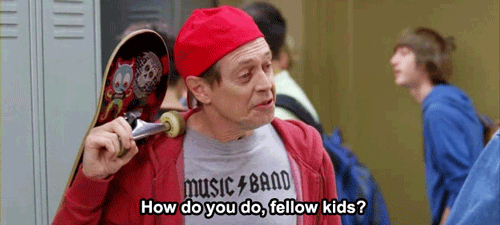
Though nothing truly forbids you to keep wearing bunko musubi, if you don't feel confortable with a bow knot or its variations (for ex. this one or this one?), don't despair! there are many (like MANY) other knots which would work with your age and "status" :D
If you wish for something classical, I'd recommend:
Kai no kuchi musubi (clam mouth knot) - a super all purpose knot, worn by women and men alike. It's been around for ages and never went out of style!
Ronin musubi (ronin knot) or katabasami - unisex knots that have been around for a long time too, pretty sturdy and chic.
Karuta musubi (card knot) - easy to tie and quite flat so perfect if you have to ride a car/train or sit on Western chairs.
Taiko musubi (drum knot) or tsunodashi musubi (also called Ginza musubi) - you can fake those ones (usually tied with wider obi) with a hanhaba obi, see examples here and here.
More on the novelty side :
Kamifusen musubi (paper balloon knot) - a more whimsical knot but could still work depending on your style. It asks for preparation but it's very cute :)
Neko mimi musubi (cat ears knot) - there are many variations, with or without hanhaba obi - look at this one for ex
Not-tied obi, a super modern way of wearing obi. Ayaaya has a lot a those, check for example this one and look at her socials for more (especially "frilly" variations)
Any variations of what I call the "waterfall" musubi, where obi ends are elegantly arranged thanks to elastique belts. It's super fashionable atm, see it shown step by step on Billy Matsunaga's channel.
To go further, searching for "hanhaba obi musubi" will gives you a lot of other ideas ;)
Hope it helps, and that you'll have a lot of fun at matsuri!
#ask#hanhaba obi#obi musubi#obi#obi knot#musubi#yukata#kai no kuchi#ronin musubi#katabasami#Karuta musubi#Taiko musubi#tsunodashi musubi#Kamifusen#Neko mimi#modern kimono#step by step#tutorial#how to#kitsuke#着物#帯
197 notes
·
View notes
Text
The look of... VII: Mukojima
Welcome to the 18th installment of this series (my 7th). This time, we’re having a look at the Geigi that work in one of Tokyo's Hanamachi: Mukojima (向島).

Historical context Geisha started to live in Mukojima in the early Meiji period (1868-1912) [1]. From the Edo to Meiji period, Mukojima was a recreational area for the common people, and was frequented by Yanagibashi and Yoshiwara Geisha with their customers. [3] The earliest record of a Mukojima Geisha (known to me) is Omomo お百, who was featured in "Contemporary Beauties", 1897 [2]. In 1906, 30 Geisha lived in the area. By 1928, their number had increased to 239. In 1940, several Kenban united, further increasing the number of Mukojima Geisha to 1300. Like in all Hanamachi around Japan, their number declined steadily after the second world war. In 1951, their number was 600, in 1993 240 [7], in 1996 170, in 2007 120 [3], in 2020 around 90 [4]. This makes Mukojima approximately as populated as Gion Kobu and Tokyo's largest Hanamachi.
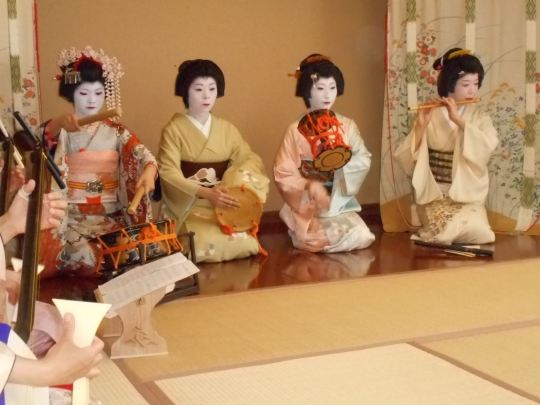
The look of Mukojima Geiko. Local Term: Geisha 芸者 ※ Hairstyle: Taka shimada, Tsubushi shimada ※ Kanzashi: Kushi, Maezashi, Hirauchi or Tama in the back, rice husk in the new year period ※ Makeup: Oshiroi ※ Kimono: everyday Kimono: Homongi. Kuromontsuki Hikizuri mostly in the new year period or for Erikae, rarely non-black Hikizuri. ※ Haneri: white ※ Obi: Taiko musubi, Yanagi musubi with Kuromontsuki Hikizuri, Tsunodashi musubi with other Hikizuri ※ Obijime: mostly light-coloured. No obijime with yanagi musubi ※ Obiage: mostly red, pink, or white. Seldomly turquoise, white/green, white with red shibori (red/red-white shibori with Kuromontsuki) ※ Footwear: mostly Zori, also Geta

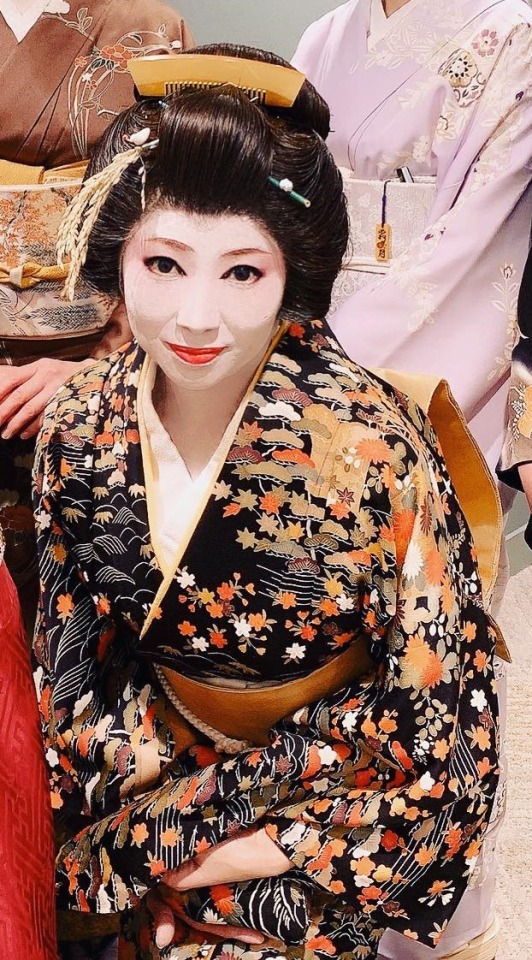
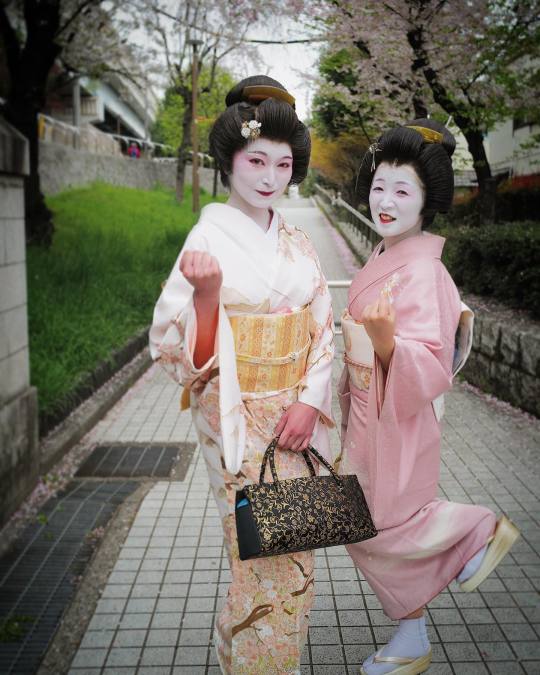
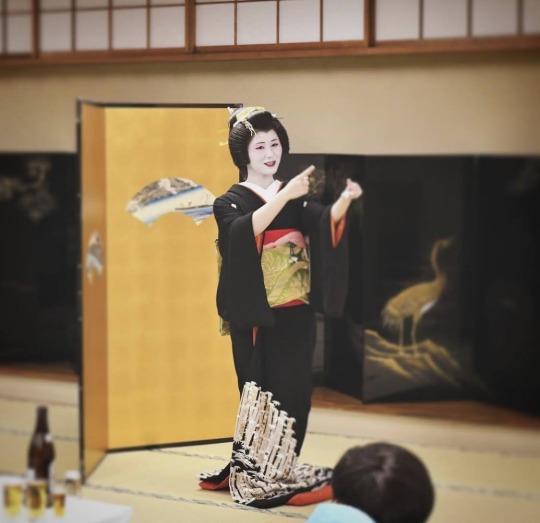
Casual/Jikata look ※ Hairstyle: Yohatsu ※ Kanzashi: none ※ Makeup: western makeup ※ Kimono: Homongi, Kurotomesode ※ Eri: white ※ Obi: Taiko musubi ※ Obijime: mostly light-coloured. In rare cases with pocchiri ※ Obiage: white with red shibori, pink, white, pink/turquoise ※ Footwear: Zori
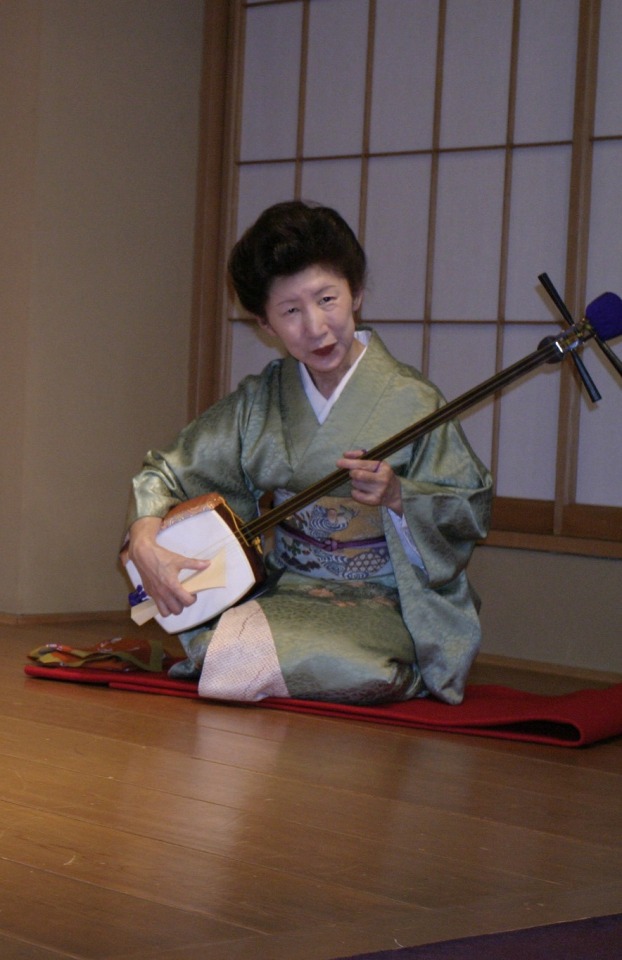
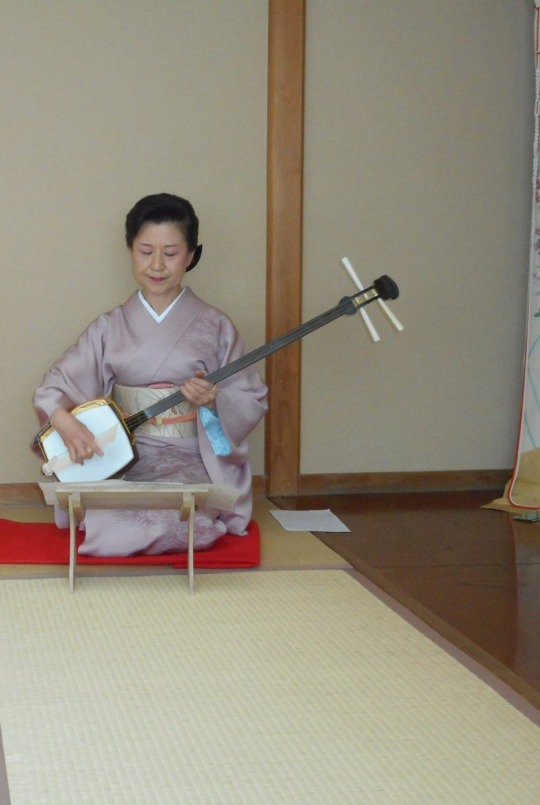
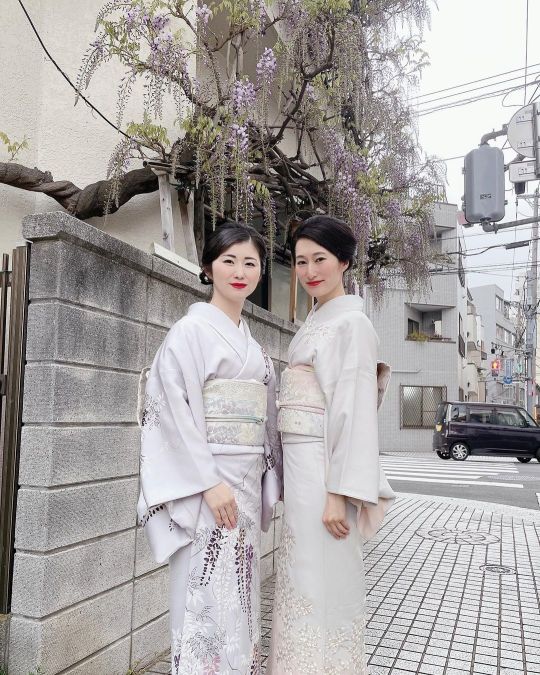
The look of Mukojima Maiko. Local term: Hangyoku 半玉 ※ Hairstyle: Momoware (own hair or wig), Yuiwata for senior Hangyoku (only wig). Shibori, Kanoko and Chinkoro are mostly red, but can also be pink during summer. ※ Kanzashi: seasonal flower kanzashi (1-2 Daikan, Katsuyama, 1-2 Bira-Ôgi, Shidare popular during the entire apprenticeship), Maezashi (optional), Hirauchi. Minimal flower kanzashi with Yuiwata. ※ Makeup: Oshiroi, both lips painted from the start ※ Kimono: Furisode with or without tucks (all variations possible) ※ Eri: mostly white or red/white. But also pink/red, red/purple/green on white base, pink, green, black/pink/white, etc., etc. ※ Obi: kôken musubi ※ Obijime: light-coloured. sometimes with pocchiri ※ Obiage: most common colour variations are red/silver, or red/white shibori. But there are many other combinations. ※ Footwear: mostly Okobo (with red or pink straps), Zori
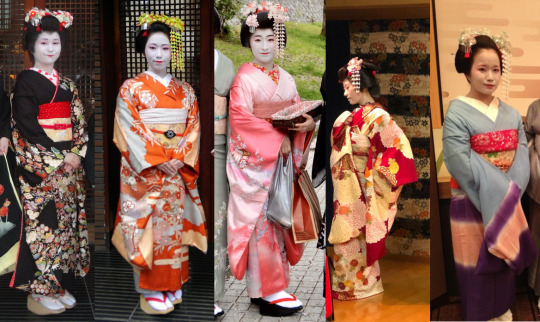
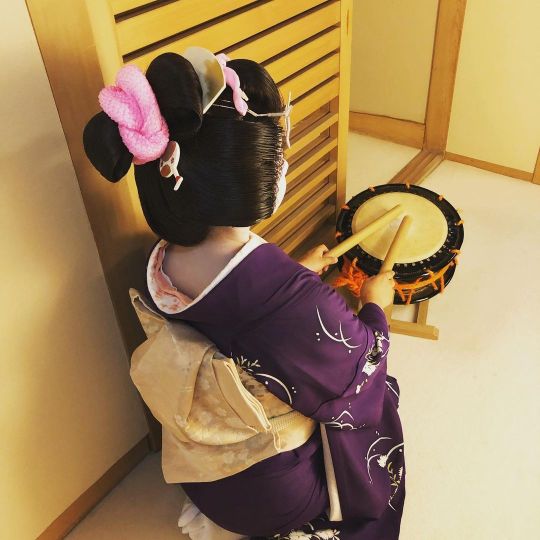
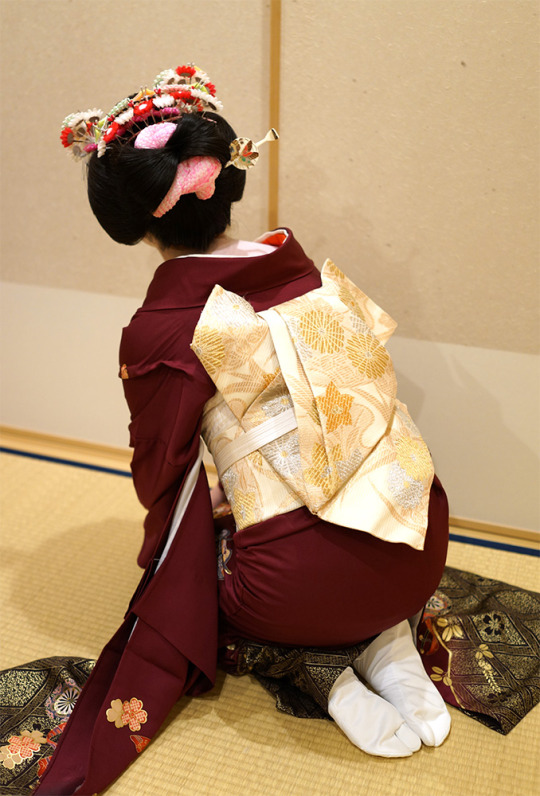
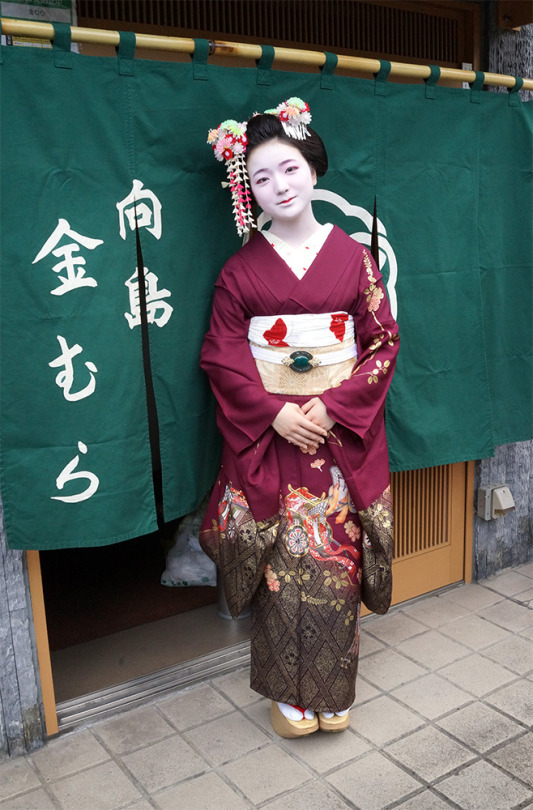

Dances [6] Some dances that are local speciality of Mukojima: ※ Asazuma bune かさずまぶね ※ Fuji musume 藤娘 ※ Fukagawa Kuzushi 深川くずし ※ Gorô ごろう ※ Mukojima ondo 向島音頭 ※ O-Sumio お角力 ※ Otemoyan おてもやん ※ Sôran bushi ソーラン節 ※ Yosakuraya 夜桜や
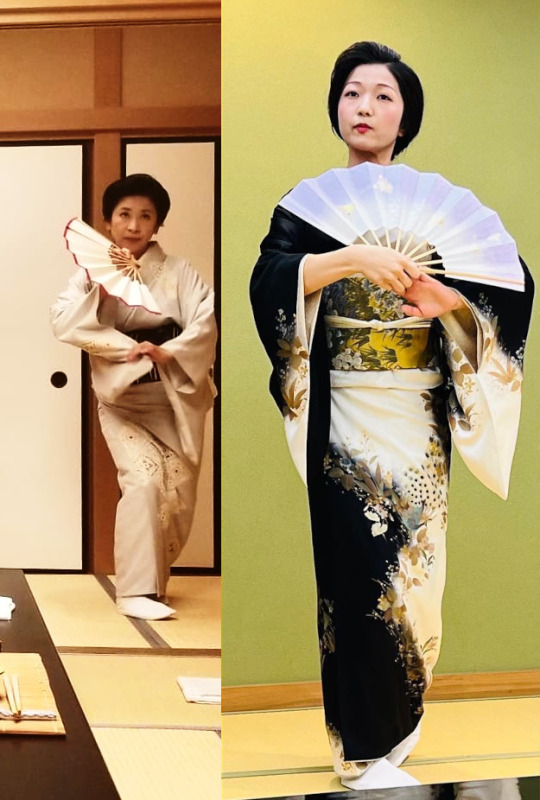
Others that you can also see in Ozashiki outside of Mukojima: ※ Ayame Yukata 菖蒲浴衣 ※ Echigo Jishi 越後獅子 ※ Hanami Odori 花見踊り ※ Hatsuharu 初春 ※ Ina bushi 伊那節 ※ Kiyari Kuzushi 木遣りくずし ※ Sawagi さわぎ ※ Setsuhonkaina せつほんかいな ※ Shichi fukujin 七福神 ※ Takeda bushi 武田節 ※ Tatsumi no hidarizuma 辰巳の左褄 ※ Tsurukame 鶴亀 ※ Yakkosan 奴さん ※ Yoshiwara Suzume 吉原すずめ
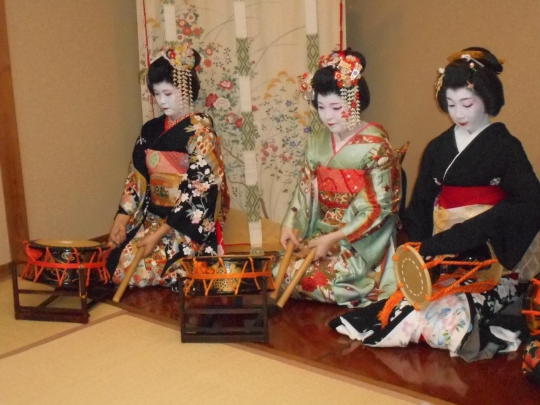
Notes Mukojima allows part-time workers, calling them Kamome かもめ [5]. Most of them are students or work in a different job already. Their task is mainly assisting Geisha/Hangyoku in the Ozashiki. Kamome can become Hangyoku or Geisha if they wish to work full-time. Mukojima dancers also play instruments at ozashiki: Hangyoku frequently play shime-daiko, Tachikata more often play ko-tsutsumi, sometimes fue. Shamisen seems so be reserved for Jikata.
Usually, Ryotei and Okiya are separate businesses in Tokyo. In Mukojima, however, several Ryotei also function as Okiya [3], similar to how in Kyoto, several Ochaya also have an attached Okiya.

Sources - Text [1] Foreign Press Center Japan, Mukojima Press Tour April 2006 https://fpcj.jp/en/assistance-en/tours_notice-en/p=6744/ [2] https://www.flickr.com/photos/blue_ruin_1/28442353867/ [3] numbers 1906-1951, 1996-2007: Sumi Asahara "Tokyo Rokkagai", 2007 [4] not an exact number (account required) https://www.tapatalk.com/groups/tsurukomaiko/hanamachi-population-reference-wip-t2000.html [5] Kamome http://sengoku-japan.com/ [6] dances compiled at Tsurukomaiko, it's by no means a complete list (account required) https://www.tapatalk.com/groups/tsurukomaiko/list-of-dances-in-all-hanamachi-t1988.html [7] 1993: Tsuiseki (追跡): The World of the Geisha, ca. 1993 https://www.youtube.com/watch?v=bkhRWNDwTyM Sources - Pictures Omomo ※ Kingyo Ozashiki ※ Momoka ※ Komachi ※ Yuki+Otokichi ※ Chikage ※ Senyume ※ Hiroya ※ Chikage+Natsuki ※ Tamaki ※ Shingetsu ※ Natsuki (twitter) ※ Soraka (insta) ※ Tomoka ※ Kingyo (fb) ※ Teruka 2x ※ Kanzashi ※ Kintaro (insta) ※ Ayame ※ Kingyo+Rin Ozashiki (fb) ※ Sakura matsuri 2023 I tried to trace back all pictures. If you find the missing links, let me know. "The look of" other Hanamachi: Yamagata, Tokyo Yoshicho, Niigata, Atami, Gifu, Tokyo Kagurazaka, Arima Onsen, Tokyo Asakua, Nagoya, Tokyo Shinbashi, Anjo I Osaka Kitashinchi, II Tokyo Akasaka, III Osaka Nanchi, Fukuoka, V Yuzawa, VI Morioka More Mukojima content: https://maigeiko.tumblr.com/tagged/mukojima Layout: @geimaiko, thanks as always! ♥
75 notes
·
View notes
Text
A kimono dealer in Japan mentioned that he might, potentially, possibly maybe, get a small spot on a news show about his shop.
"Estate Sale" style lots of assorted items to bid on is not common in Japan like it is here. So odd lots of old kimono are very cheap, often $100 USD or less for half a dozen items. But they aren't necessarily items that would be worn together, if someone has a sense of formality, colours, types of kimono, etc. They're great for mixing with yofuku or maybe photoshoots as-is, but if using as intended...
Look y'all. The autistic gaijin kimono collector most certainly didn't take this as a sign to make review photos as perfect as possible. Right?




The first set:
The kimono + fan came from Kazuma. The other items are from my collection.
The single-layer synthetic kimono reads as an odori piece, so it's paired with a gold odori obi and bold red accessories. The collar and obiage match in fabric type (ro) but I don't have a red summer obijime (the cord on the obi belt.) I thought one might not have the right effect if this were on stage anyways. The fan is also for dance performances.
I think now, I should have done bunka musubi, but I went with a long hanging obi inspired by geisha in Tokyo area.



For this, I chose entirely summer items, ro whenever possible to match the juban. This only features the summer obijime from the lot.
The nearly-black colour with pampass grass is a symbol of deep summer and a hope for coming coolness. Dark eggplant purple and brilliant gold is another summer choice, linking with January references to eggplant and a desire for cool weather. The obi is tied in a big, airy otaiko in an asymmetric knot, a reference to days of kitsuke long gone by.
The brilliant red obiage is a classic pairing, and the nearly-white blue obijime is the colour of snow. They stand out against the colour of the obi very well. The obijime very nearly matches the grass pattern.
The fan tucked into the obi is made of light-coloured wood (dark wood is for autumn and winter) and has a simple pattern of swirling green maple leaves, tinged in gold. Momiji (maple) will not become gold until later in Autumn. Right now, green and black are vibrant, and the gold in the fan pairs with the gold in the obi. Hints of a breeze also evoke a cool feeling.



For the last set, the fukuro obi and michiyuki is from Kazuma.
I picked a bold floral hitoe kimono with komono (accessories, lit. "small things") that were bright and cheerful. The collar and obijime match here, pulling from the purple details in the flowers. The obi also has elements of orange and gold, akin to the orange and yellow in the flowers. The white silk obiage has cute triangles of bright colours, in pinks, yellow, orange, and turquoise.
I wanted to make something a fun 20-something would wear out with friends.
Since the kimono is so youthful, as are the coordinating pieces, I wanted to do something ... not boring.
A musubi that is not ginza/tsunodashi, otaiko, or ribon (ribbon). Something cute! Fluffy looking! Effeminate! Something that in passing, is layered and has curves like the tiny flowers in the kimono. Maybe I was successful.
The obiage too, I wanted to be youthful but not childish or too "formal" like a furisode. Especially since the "creative" musubi (knot in the back of the obi) are too often reserved only for the long-sleeved formal kimono. Hnnn. I wrapped it in a way to show off the colourful patterns and tucked in one side to make a cute ruffle, again to mimic the obi and kimono pattern.
A plain obijime then, would be boring by contrast... so maybe don't make it TOO showy, like it's a furisode, but a little bit wavy and fanciful.
How did I do?
5 notes
·
View notes
Text
You Asked For It: Akasaka Geisha
This video, which seems to be showing a short 'day in the life' sort of thing? Was a really enjoyable watch! ^^ I have some questions though, which I honestly don't know the answer to. At point 0:50 in the video, the narrator says the "Hokoya" or "Hakoya" has arrived (I've got no clue what the narrator is saying, since the pronounciation is very butchered), and that he does their makeup, dresses them and ultimately acts as a father figure to the geisha. (Perhaps an Otokoshi, just more involved and a regional difference for the word?) Could you give some insight on this? I've never heard of this before. At 2:10 the okaa-san arrives, she's seen rocking a Hikizuri with the Tsunodashi musubi! She looks great, however instead of wearing the Tsubushi shimada, she seems to be wearing Maru-mage shimada. I've also never seen this before, again... Could you explain this? ^^
youtube
@maigeiko You were the first person that popped into my mind, since you're so knowledgeable about Geisha outside of Kyoto.
30 notes
·
View notes
Text
Big Bold Bamboo
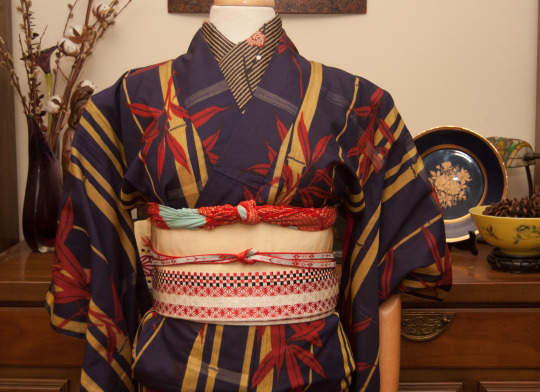
My finger has healed enough for me to do kitsuke, and while I did say I was looking forward to coordinating my new shrimp obi, this big bold bamboo piece from Ichiroya was calling my name. It took me a while to find the right obi for it but this one feels perfect. It's pale so it brings light and contrast to the outfit, but the reds and yellows tie them together nicely. I went for more stripes with the haneri, and think it blends in well but still feels distinct. A few hits of pale blue and bold red in the obiage and obijime helped bring some more brightness into an otherwise very muted coordination. I also think this is probably the nicest tsunodashi musubi I've ever tied, but honestly that's not saying much. For some reason it's always given me difficulty! It definitely feels easier for me to tie using a hakata obi like this one, so now I want to try it again with another hakata obi soon. Read the full article
1 note
·
View note
Text
youtube
I quite like this tutorial on how to make a tsunodashi musubi with a hanhaba!
#kimono-daisuki#kitsuke#tutorial#video#youtube#obi musubi#着付け#帯結び#obi#hanhaba#hanhaba obi#kimono#きもの#着物#キモノ#帯#半巾#半幅#半幅帯#半巾帯
54 notes
·
View notes
Note
Do geisha wear the tsunodashi musubi? I've read that they used to in the Edo period.
There are some geisha today that will still wear the tsunodashi musubi today, but you won’t find anyone in Kyoto wearing it ^^
11 notes
·
View notes
Photo
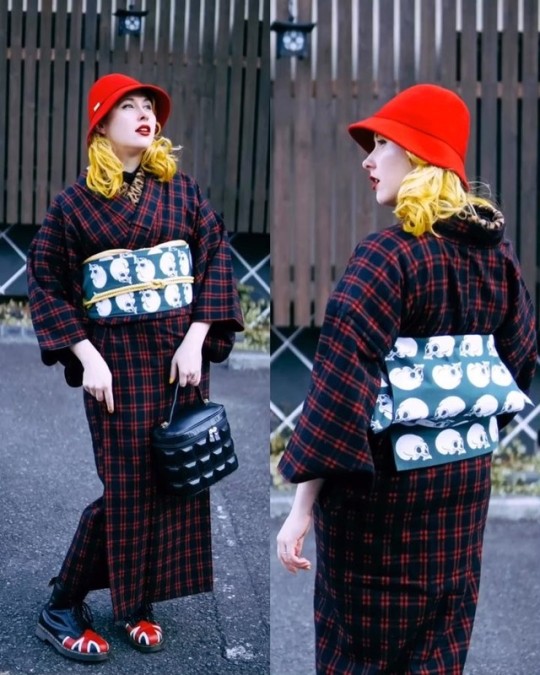
Here is part 2 of my “Get ready with me” video 👘❤️ Tying the Nagoya obi into “Ginza musubi” / “Tsunodashi musubi” 🥳💕 My favourite way of wearing Nagoya obi. In the video you see me struggling a little - that’s me not having worn kimono enough recently so I start forgetting 😂🙈 Also try to count how often I was sneezing 🤣🤣😆 Hopefully this video will help you tie your obi ❤️ 「Get ready with me シリーズ」次は名古屋帯で「角出し結び」又は「銀座結び」名古屋帯ならいつもコレ❤️ (ただ最近は着物着てなくて、最初にどうでしたっけ?みたいに混乱したw) まあ、参考になればと思います。😂👘💕 Kimono: wool (vintage) Obi: @modoribashi.kento.watanabe (Only yellow and pink available) Boots: @drmartensofficial #salztokyo #salzkimono https://www.instagram.com/p/BtYrjeQnolZ/?utm_source=ig_tumblr_share&igshid=g2dwoqbjgyer
17 notes
·
View notes
Note
What's an otoko?
otoko (男) means man/adult male. For the lack of a better word I used it in "the look of Hakone" for Geisha who portray male roles during dance. Actually, it seems to be called "Tachiyaku" 立役, same as in Kabuki. Their styles differ only very little throughout the country, and the universal differences between costumes for female roles are: Maeware hairstyle instead of Shimada (Geiko/Taka/Tsubushi Shimada) Kimono with normal length instead of Hikizuri Koken musubi (obi knot) instead of Taiko/Yanagi/Tsunodashi musubi In some cities (for example Sapporo and Hakone), they wear an extra strip of fabric on the lower edge of their Obi, which is called Kakae Obi (抱え帯) Here are some example pictures from Sapporo: https://sitakke.jp/post/8068/
8 notes
·
View notes
Text
Some minor updates for 2025: ※ after being Geisha for three years, the hairstyle changes from Taka Shimada to Tsubushi Shimada ※ Tsunodashi Musubi is the standard Obi Musubi paired with Hikizuri, although there are exceptions (recent Debut/return of Koume showed her wearing Taiko Musubi with Hikizuri)
The look of... II: Tokyo-Akasaka
Historical Context The history of Akasaka as a Hanamachi starts in 1869, when it was established with 20 Geisha in three Okiya. In 1883, it was ranked as 24th lowest of 25 Hanamachi in Tokyo. During the Russo-Japanese war (1904/05), Akasaka’s wealth grew: by 1906, there were 65 Okiya, the most famous ones being Harumoto 春本 and Hayashi-ya 林家, both with more than 12 Geisha each. The legacy of Harumoto lives on with present-day Okiya like Kazuharumoto 一春本 and Hisamomoharumoto 久桃春本. The number of Geisha and Hangyoku living there reached its peak in the late 1920’s (1928: 425). In 1986 the last Akasaka Hangyoku of the 20th century debuted. In 2014, Sakura was the first of currently three Hangyoku of a new generation. In 2022, 21 Geisha work in Akasaka.
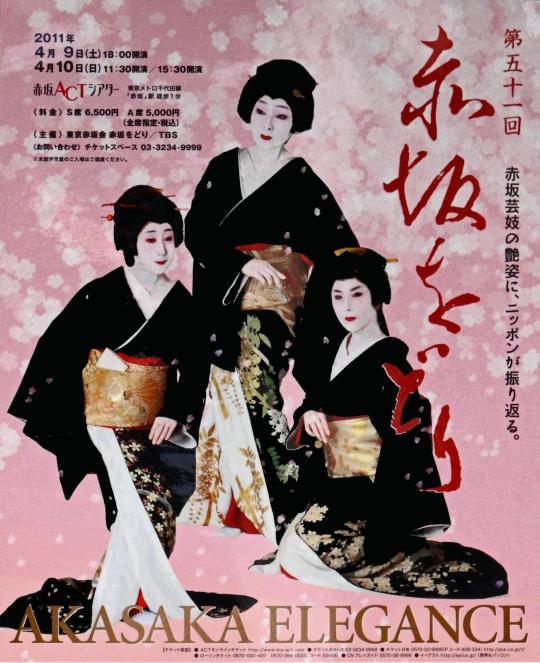
The look of Akasaka Hangyoku ※ Hairstyle: Momoware, created with the Hangyoku’s own hair, but Katsura is also possible! ※ Kanzashi: seasonal Hanakanzashi (Daikan+Katsuyama, often with Shidare), red Kanoko, Hirauchi, Kanokodome, one Bira-Ogi ※ Makeup: Oshiroi, both lips painted red from the start ※ Eri: red with white embroidery, sometimes with additional pink/gold details ※ Kimono: Chû-Furisode with shoulder tucks. Sleeve tucks are optional ※ Obiage: red with silver embroidery, flat on top of the Obi ※ Obi: Jidai Kôken Musubi ※ Obijime: flat with Obidome ※ Footwear: Zôri and Okobo

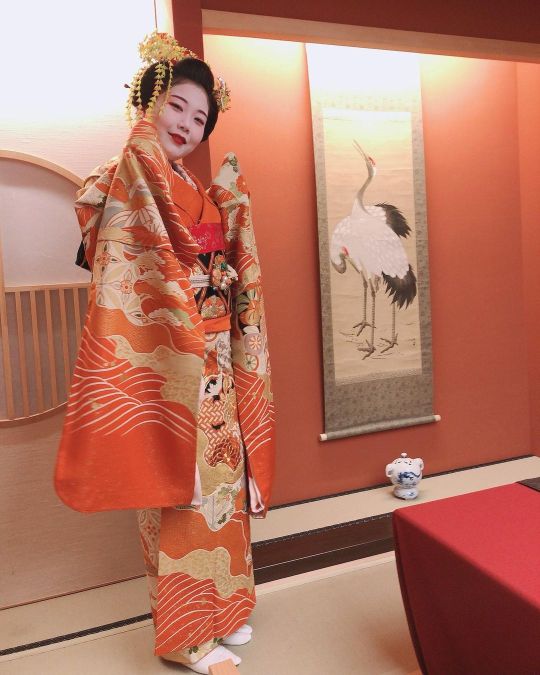


The look of Akasaka Geisha ※ Hairstyle: Taka Shimada, after three years change to Tsubushi Shimada Katsura ※ Kanzashi: Kushi, Hirauchi, sometimes Maezashi, more often Ichidome in the front (common types are Mochidashi Kanzashi and Kotoji Kanzashi) ※ Makeup: Oshiroi ※ Eri: white ※ Kimono: Hômongi at debut, otherwise Hikizuri ※ Obiage: red, pink ※ Obi: Taiko Musubi with short Kimono, Tsunodashi Musubi with Hikizuri, Yanagi Musubi with Kuromontsuki. ※ Footwear: Zôri
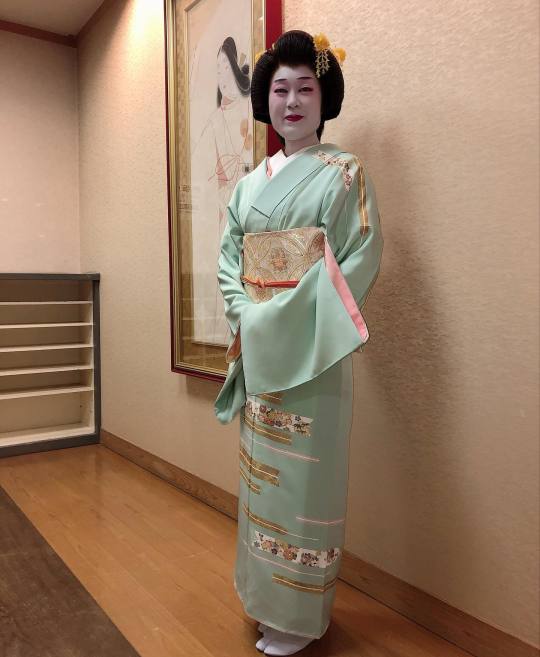


Notes Hangyoku are a rare thing in Akasaka. The first Hangyoku to debut since 1986 was Sakura (さくら) in 2014. I could find only one picture of her online of when she still was a Minarai. After her came Koume (小梅), who was active for three years (2016-18), but there aren’t a lot of pictures of her online. Mameka (まめ夏), who debuted in 2018 and became a Geisha in 2021, graced us with her own instagram account, posting many pictures of her outfits, so she is basically my only source for “the look of Akasaka Hangyoku”. Kikumaru is my only source for the way a Geisha is outfitted at debut. When Mameka debuted in October 2018, she wore a wig and continued to do so until February 2019. It also seems there isn’t a uniform tradition revolving around Hangyoku debuts in this district. Koume wore Kofurisode, minimal hair decoration and had only her lower lip painted red. Mameka wore Chû-Furisode, normal hair decoration (as described above in “Kanzashi”) and had both lips painted red. Regarding Kôken Musubi. It seems the difference between “normal” and “Jidai” Kôken Musubi are the folds in the middle of the upper edge


Sources Kanzashi terms, Akasaka history, Minarai Sakura, “Jidai Kôken Musubi”, Akasaka Odori 2011 poster, Mameka Debut 2018, New year 2019, Obi photo 2019, Kikumaru debut 2020, Kikumaru July 2020, Mameka November 2020, Kikumaru February 2021, Mameka February 2021, Mameka April 2021 Layout: @geimaiko (thanks as always!) Original post from Jul 2022, last updated Feb 2025
99 notes
·
View notes
Photo


Shimoda Geisha photographed by Jeremy Sutton-Hibbert in December 2011. Awagiku (in white), Iroha (in pink) and Rinka (in black) debuted as Geisha in March 2012. On the second photo, you can see Hanamaru (in purple) with them, a senior Geisha. The style of the Shimoda Geisha is quite eclectic - you can see, they wear two different types of Kimono: the Geisha to debut wear Hikizuri Hanamaru wears Hômongi ... three different types of Katsura: Awagiku and Hanamaru wear Geisha Shimada with long wires that have feathered ends - other city’s Geigi and bride’s Taka Shimada wigs have wires that are usually a bit shorter and much narrower Iroha wears Yuiwata Rinka wears Tsubushi Shimada ....and four different Obi Musubi: Hanamaru wears Taiko Musubi Awagiku wears Bunko Musubi Iroha wears Yanagi Musubi Rinka wears Tsunodashi Musubi There are also Maiko in Shimoda (I don’t know what the regional term is). Visually, their main difference from the Geisha are the bright, modern Furisode they wear and the wig decoration. A lot of features are shared with the Geisha: white collar, tied Obiage, Yuiwata wig, Taiko Musubi Obi.
#Shimoda#MG#onsen geisha#tsunodashi musubi#Yanagi Musubi#2011#december#Awagiku#Iroha#Rinka#Hanamaru#tsubushi shimada#yuiwata
40 notes
·
View notes
Photo



Kimono silhouettes studies by Matsuo Hiromi, showing:
1+2 - a refined hikizuri trailing kimono dressed with tsunodashi obi knot (this iki style was promoted by Edo era Geisha).
3 - a bride outfit (note the long furisode sleeves + different accessories) and a “classical” kimono outfit
If you are interested, this is how tsunodashi musubi are tied:
youtube
#japan#fashion#kimono#hikizuri#susohiki#tsunodashi musubi#references#drawing references#how to#kitsuke#geisha#edo#bride
747 notes
·
View notes
Photo


Sapporo, September 2018: from left to right: Chie, Koume, Kotoyo. You can see that Chie and Kotoyo tied their obi with a tsunodashi knot on the second picture. Sources. First picture, second picture.
79 notes
·
View notes
Note
Hi. I'd like to ask how different are the practices of Asakusa Geisha to Kyoto's Geiko from their appearance and traditions they follow in their respective Kagai.
Practices: school of dance: Fujima (like in Gion Higashi) and Hanayagi (like in Kamishichiken) Odori: One annual Odori, like in Gion Higashi. In Asakusa, there's the the Asakusa Odori (used to be called different). It was held rather irregularily until 2019. Since then, there is an Asakusa Odori every year. Festivals: like in Kyoto, there is a Jidai Matsuri held each year in November. Only Asakusa Geisha participate (first held in 1999). Then, there is a large shrine festival called Sanja Matsuri in May, it seems to be it's similar to Kyoto's Gion Matsuri. There is public dance by Geisha and Furisode-san alike
Joint venture: since around 1993, a dance/music event "Miyako no Nigiwai" is held by all five Kagai in Kyoto. A similar opportunity to see Tokyo Geisha is the “Oedo vaudeville show and Geisha dances” since 2010. It's organised by the Tokyo arts council. They gather a lot of performers including selected Geisha and Taikomochi from the main six Tokyo Kagai to present their skills to a broader audience.
Dances ...that are part of the Asakusa Geisha’s repertoire, but not performed in Kyoto: Asakusa meibutsu 浅草名物, Chakkiri Bushi ちゃっきり節, Fukugawa Bushi 深川節, Kiyari kuzushi 木遣りくずし, Yakkosan 奴さん, etc...
Appearance: Hangyoku, where they are different from Kyoto Maiko. There is no clear change in looks as they progress from junior to senior. Hair: Asakusa Hangyoku mostly wear a wig instead having their own hair styled, opposed to Kyoto Maiko, who mostly don't wear a wig ( unless for special occasions). They use only one hairstyle: Momoware (similar to Wareshinobu). The chinkoro and arimachi kanoko on their wigs is mostly red, but can also be pink. Kanzashi may use different motifs compared to Kyoto (for example cranes in January). The collar (Eri): mostly red/white. In rare cases, it can be pink or red with gold (imagine the red Sakkô collar from Kyoto). Kimono: Furisode instead of Hikizuri, mostly with shoulder tucks, sometimes without, never with sleeve tucks. On occasions where their older sisters wear Kuromontsuki, the Hangyoku don't wear anything out of the normal. Black Furisode seem to be exceptionally rare. I've seen it on three occasions only - a new year celebration in 2008, Chiho's debut in 2021 and Tamaaki’s debut in 2022. Obiage: mostly red with silver embroidery, but can also be white with red shibori or unicolour pink Obi: the knot is called “Kôken musubi” Obijime and Pocchiri: Pocchiri are seldomly worn. They are a bit simpler and smaller, compared with what you may be used from Kyoto Maiko. Footwear: naturally coloured Okobo with red straps, seldomly Zori
junior Geisha from head to feet Kanzashi: solid-coloured Kushi and metallic flower maezashi Hair: Katsura, Geisha shimada Kimono: Hômongi/Tsukesage Obi: taiko musubi Footwear: often black Geta (not seasonally restricted). Zori are rather rare.
senior Geisha from head to feet Kanzashi: Kushi, often with little metallic Maezashi, red/green Tama kanzashi Hair: Katsura, mostly Tsubushi shimada, but also Geisha shimada Kimono: Hikizuri Obijime: only with taiko musubi, which is rarely worn by senior Geisha Obi: standard knot Tsunodashi Musubi, Yanagi Musubi with Kuromontsuki. Rarely Taiko Musubi with Hikizuri Footwear: same as junior Geisha
jikata Geisha Hair: always Yohatsu Kimono: Hômongi/Tsukesage, Kurotomesode at formal events Obi: taiko musubi Footwear: Zori
light-weight In late spring/Summer, especially in May during Sanja Matsuri, Asakusa Geisha can be seen wearing Ro Hikizuri in a similar manner like Yukata: without Nagajuban, so you can see the red collar of the hadajuban underneath the Kimono collar. They also wear Yukata quite often.

Taikomochi Asakusa is at the moment home to six Taikomochi, this job is the origin of today’s Geisha. The last Taikomochi in Kyoto retired in the late 1940's.
I also recommend reading @geimaiko ‘s “the look of Asakusa” Sources: own picture collection (best source if you wanna analyse visuals but can’t ask anyone involved directly), Wikipedia (1, 2), the Gei of Geisha book, Tokyo Arts council site
Last updated: 10. Oct 2023
31 notes
·
View notes
Note
Hai, First of all; Beautiful tumbler page!! The question i like to ask is; Is anything known of different traditions of Geiki and Maiko outside of Kyoto? Like the Shachihoko dance of Osaka Geisha, or ( in Pontocho, Kyoto), the different hairstyles of Maiko reaching the Erikae?
Hi and thanks!
The Sachihoko dance is a trademark of Nagoya, but they do it in Ôsaka (and Kyoto) as well!
Some examples I can think of:
- in Nara, Sakkô Hikizuri is almost completely black with red lining
- in Gifu, when Maiko entertain on boats, their Obi is tied up and resembles the “ya giccha musubi”, so it doesn’t get in the way.
- the trademark of Ôsaka Maiko is the Ya giccha musubi
- Akita had no Maiko for an undisclosed period of time, until three of them debuted in 2014. Their look changed a lot and it seems that they have finally settled to their unique style in Autumn 2018.
- in Fukuoka, the Hangyoku usually wear Momoware wigs, Furisode and Handara musubi. At certain events, Fukuoka Hangyoku wear Iromuji+Handara musubi or Hikizuri+Darari musubi like Kyoto Maiko. Kanzashi wise, they always wear a Kushi intead of a flower Katsuyama
- Furisode-san in Niigata wear only two different types of Obiage: 1. pink with white waves, 2. red with white flowers. The pattern of the Obiage also always matches the pattern of the Eri. It’s a seasonality thing.
- in Sapporo, all Geiko wear Tsubushi shimada wigs, which is a hairstyle for senior Geiko in other hanamachi. Similar to Gion Kobu, Maiko tie their Obiage in the last month of their apprenticeship.
- in Tokushima, Geiko and Maiko often wear matching Hikizuri/Furisode. Maiko’s Obi are tied as Fukura-suzume or Bunko musubi, which is not worn by other Maiko/Hangyoku. Geiko wear identical Kuromontsuki and pair them with identical golden obi.
- in Tokyo, each Hanamachi has a very distinct style; opposed to a certain uniformity you can find in Kyoto. Senior Geisha in Asakusa wear Tsunodashi musubi as their daily Obi style, Hangyoku in Asakusa hardly ever style their own hair when at work.
Hachioji Hangyoku don't wear wigs. Their hairstyle is Ofuku and it looks a bit different compared with Kyoto’s Ofuku. Their seasonal flower kanzashi change around the 20th of each month and not at the beginning.
In Mukojima, they have more Kanzashi variety than any other hanamachi. Mukojima Hangyoku can choose if they want to wear a wig or have their own hair styled. The "own hair" Momoware looks a bit different from behind than the Momoware of other cities. Senior Hangyoku can have their wigs styled as Yuiwata. All Mukojima Geisha wear Hômongi for work and their only Hikizuri are Iro- and Kuromontsuki.
Shinbashi never has a lot of Hangyoku, so it’s a bit hard to observe their style. Similar to Asakusa, they wear a Momoware-wig almost every day. But during the Azuma Odori, they will have their own hair styled.
- in Yûzawa, Maiko look very much like Kyoto’s Maiko, but wear wigs instead of having their own hair styled. However, from 2020 onwards, the single Maiko active has had her own hair styled the entire year, bringing her even closer to the typical Kyoto Maiko look.
That’s all, folks! (Last updated April 2021)
#MG#asks#Nara#Gifu#osaka#akita#fukuoka#niigata#sapporo#tokushima#Tokyo#Asakusa#hachioji#mukojima#shinbashi#yuzawa
54 notes
·
View notes
Note
hi there! I was wondering about the look of Tokyo Geisha. Why is their look so inconsistant? For example some hangyoku wear wigs, some don't. Why is that so?
All districts have their own traditions, and as the Tokyo Hanamachi are more modern compared with Kyoto. For example: Hachiôji, where Hangyoku style their own hair, wasn’t even a part of the Tokyo prefecture until 1893.
An important difference (if you take Kyoto as reference) is that some wear Hikizuri, some wear short Kimono, some wear Taiko Musubi, some Tsunodashi Musubi, etc. … there is actually consistance in that: the “starter outfit” for a Geisha in Tokyo is: Geiko/Geisha Shimada wig, Obi tied as Taiko Musubi and a standard length Kimono. Older and more experienced Geisha wear a Tsubushi Shimada wig, their Obi knot is Tsunodashi Musubi and they actually wear Hikizuri!
On top of that, there is a third kind of tying your Obi: Yanagi Musubi, which is reserved for formal outfits (i. e. when they wear a Kuromontsuki).
So, their looks are not actually inconsistant, but more varied. Hope this answers your question!
26 notes
·
View notes